Want bigger lifts without a bigger grocery bill? You can build muscle on a tight budget and still enjoy your meals. The trick is hitting protein targets, buying the right staples, and planning a bit so nothing goes to waste.
In this guide, you’ll get clear protein targets, the cheapest protein, carb, and fat picks, plus a simple 7 day plan with a grocery list. Prices change by store and region, so we’ll focus on cost per serving and cost per 25 grams of protein. That makes your choices easier anywhere you shop.
Stick around for practical swaps, fast meal prep, and easy pairings. You’ll leave with a plan you can use this week. The goal is simple: use cheap food to help build muscle, keep taste, save time.
Build muscle on a budget: how much protein, calories, and planning do you need?
When money is tight, strategy matters more than fancy foods. You need enough protein for muscle, a small calorie surplus to grow, and a plan to stretch every dollar.
Protein drives muscle repair. Aim for 0.7 to 1.0 grams of protein per pound of body weight. Spread it across 3 to 5 meals, 25 to 40 grams each. That spacing supports recovery all day and helps you feel full on a budget.
Calories still count. Gaining too fast adds fat that you’ll need to cut later. Target a small surplus, about 200 to 300 calories over maintenance. That gives you steady gains without draining your wallet.
Carbs and fats fuel training and hormones. Carbs help you train harder and refill glycogen. Fats support hormones and help you hit your calorie goal without eating huge volumes. A simple split like 30 percent protein, 40 percent carbs, 30 percent fats works well. You can shift it based on your energy and appetite.
Planning is your money saver. Read unit prices, buy larger packs, and use frozen or shelf stable foods to avoid waste. Batch cook once or twice a week so protein is ready to go. A pot of rice, a tray of chicken, and a pot of lentils can anchor 10 to 15 meals. Store portions in the fridge for the next three days and freeze the rest.
Keep it simple. Compare cost per 25 grams of protein, then pick the cheapest items your store has stocked. You can win this with thighs, tuna, eggs, beans, rice, and oats. The muscle does not care about fancy labels, it cares about protein, calories, training, and consistency.
Set easy protein targets by body weight
- Aim for 0.7 to 1.0 grams of protein per pound per day.
- 120 lb person: 85 to 120 g per day.
- 160 lb person: 110 to 160 g per day.
- 200 lb person: 140 to 200 g per day.
Space protein across the day. Hit 25 to 40 grams per meal, 3 to 5 times per day. That range fits eggs, yogurt bowls, tuna and rice, or a chicken plate.
Vegetarian and vegan targets are the same. You may need larger portions or blends like beans plus grains or tofu plus edamame. That helps round out amino acids and meet leucine needs for muscle growth.
Simple calorie and macro guide for muscle on a budget
- Estimate maintenance as body weight x 14 to 16.
- Add 200 to 300 calories to gain slowly.
- Start with 30 percent protein, 40 percent carbs, 30 percent fats.
Adjust each week. If the scale has not moved for 7 to 10 days, add 100 to 200 calories. If you gain more than 1 pound per week for several weeks, trim 100 to 200 calories. Keep training hard and walking daily.
Smart shopping moves that save money every week
- Read unit prices. Compare price per ounce, per pound, or per gram.
- Buy store brands when quality is the same.
- Shop weekly ads, stock up on sale protein, and freeze.
- Choose big packs of chicken thighs, drumsticks, or ground turkey.
- Use frozen veggies to cut waste and prep time.
- Buy dry beans and lentils if you have time, canned beans if you need speed.
- Track cost per 25 grams of protein for each item you buy.
Batch cooking and safe storage to cut waste
Plan a simple weekend cook:
- Cook a pot of rice or oats.
- Roast a sheet pan of chicken thighs and potatoes.
- Simmer a pot of lentils.
- Portion snacks like yogurt with fruit or nuts.
Storage rules:
- Fridge: 3 to 4 days for cooked meat, grains, and beans.
- Freezer: 2 to 3 months for cooked meats, beans, and rice.
- Label portions with date and amount of protein. Aim for 25 to 40 grams per container so you can grab and go.
Cheap food to help build muscle: proven staples that work
You do not need expensive cuts to grow. These staples are affordable, high in protein, and easy to cook in batches. Look at protein per serving and cost per 25 grams of protein. This quick metric helps you compare chicken, tuna, eggs, and beans fairly.
Leucine, the amino acid that flips the muscle building switch, is rich in eggs, dairy, tuna, and whey. Beans and lentils still build muscle well, especially when you pair them with grains or soy.
Here is a simple view of value. Prices vary by region and store.
| Food | Protein per serving | Typical price range | Cost per 25 g protein |
|---|---|---|---|
| Chicken thighs, raw 4 oz | 24 g | 1.29 to 1.99/lb | 0.60 to 0.90 |
| Canned tuna, 5 oz | 24 to 26 g | 0.79 to 1.29/can | 0.80 to 1.25 |
| Eggs, 2 large | 12 to 13 g | 1.50 to 3.00/dozen | 0.60 to 1.00 |
| Dry lentils, 1/2 cup dry | 23 to 25 g cooked | 1.00 to 1.50/lb | 0.35 to 0.60 |
| Greek yogurt, 3/4 cup | 17 to 20 g | 3.50 to 5.50/32 oz | 0.90 to 1.30 |
| Whey concentrate, 1 scoop | 20 to 25 g | 0.70 to 1.20/scoop | 0.70 to 1.20 |
| Tofu, firm 4 oz | 10 to 12 g | 1.50 to 2.50/14 oz | 0.90 to 1.30 |
Use this as a guide, then buy what is cheapest near you.
Animal proteins under $2 per 25 grams
Great budget buys:
- Chicken thighs or drumsticks
- Whole chicken
- Canned tuna or sardines
- Canned chicken
- Ground turkey, large packs
- 80/20 beef when on sale
- Eggs, the hard hitter for value and taste
Buy family packs and freeze what you will not cook in 2 to 3 days. Dark meat often costs less than breasts and still builds muscle. Remove skin after cooking if you need to manage fat.
Plant proteins under $1 per 25 grams
Beans and lentils are the backbone of a low cost muscle plan:
- Dry lentils, black beans, pinto beans, chickpeas, split peas
- Soy foods: tofu, tempeh, edamame
Pair beans with grains like rice to round out amino acids. Boost protein density by adding tofu cubes to stir fry, tossing edamame into rice bowls, or stirring lentils into chili or pasta sauce. Keep canned beans on hand for speed, cook dry beans when you have time.
Dairy and egg buys that pack protein
Dairy and eggs are high value, easy to snack on, and taste great:
- Greek yogurt: 17 to 20 g per 3/4 cup
- Cottage cheese: 12 to 14 g per 1/2 cup
- Milk: 8 g per cup
- Powdered milk for baking or shakes
- Eggs: about 6 g per egg
Choose plain yogurt for savings, then add fruit or honey. If you are lactose sensitive, use lactose free milk or try yogurt, which many tolerate better.
Budget protein powders and when to use them
Whey concentrate and soy isolate often offer the best price per protein. Aim for 20 to 30 grams per scoop. Compare cost per 25 grams of protein to your usual foods. If a scoop costs the same as eggs or tuna, use it to fill gaps, not replace meals.
A cheap shake idea, about 1 to 1.50 dollars: 1 scoop protein, 1 cup milk, 1/3 cup oats, half to one banana, water and ice. That fits after training or as a quick morning meal.
Low cost carbs and fats that power your workouts and recovery
Carbs are your training fuel. Fats help you reach calories and support hormones. The best budget plan pairs cheap proteins with simple carbs and a bit of fat. Think bowls, wraps, and soups that reheat well.
Use carbs to time energy around workouts. Use fats to make meals satisfying without breaking the bank.
Best budget carbs for lifters
- Rice: cheap in big bags, easy to batch cook
- Oats: breakfast hero, also thickens shakes
- Potatoes: one of the best cost per serving, bake or roast
- Pasta: quick, flexible, pairs with beans or turkey
- Tortillas and bread: fast wraps and sandwiches
- Bananas: quick carb for pre or post workout
- Frozen fruit: smoothies and yogurt bowls, less waste
Portion ideas: a baked potato, 1 cup cooked rice, or a bowl of oats often costs around 50 cents or less. Higher fiber choices, like oats and brown rice, keep you full longer. Faster carbs like white rice or bananas can help around workouts.
Low cost fats that support hormones
Fats are calorie dense, so small amounts go far:
- Peanut butter
- Canola or olive oil
- Sunflower seeds
- Peanuts
Add a spoon of oil to rice bowls, toss potatoes with oil before roasting, or stir a tablespoon of peanut butter into oats. These are cheap, simple ways to raise calories if you struggle to gain.
$2 pre and post workout meal ideas
Keep it simple and repeatable.
- Pre workout, 60 to 90 minutes out: banana with peanut butter, or oats with milk and honey.
- Post workout, within two hours: tuna and rice bowl, eggs and tortillas with salsa, or Greek yogurt with oats and fruit.
Target 25 to 40 grams of protein plus some carbs. Save richer fats for later meals if they upset your stomach before training.
7 day cheap muscle menu and $60 grocery list
Here is a flexible template you can use for a full week. Prices and items change, so swap based on your store. Check unit labels and watch sales. The grocery list targets about 55 to 65 dollars in many US stores in 2025.
1 day sample menu at about 120 grams of protein
- Breakfast: oats cooked in milk, topped with peanut butter and two scrambled eggs.
- Lunch: chicken thighs, rice, frozen mixed veggies, and a spoon of oil.
- Snack: Greek yogurt with banana or frozen berries.
- Dinner: lentil and ground turkey pasta with tomato sauce.
- Night snack: cottage cheese or a glass of milk and a piece of fruit.
Scale calories up by adding more rice, oil, or an extra egg. Scale down by using more veggies, less oil, or smaller carb portions.
Budget grocery list with prices and smart swaps
Core items for the week, price ranges vary by store:
- Rice, 5 lb bag: 3.50 to 6.00
- Oats, 2 to 3 lb: 2.50 to 4.50
- Chicken thighs, 4 to 6 lb: 6.00 to 12.00
- Eggs, 2 to 3 dozen: 4.00 to 9.00
- Dry lentils or beans, 1 to 2 lb: 1.50 to 3.00
- Pasta or tortillas: 1.50 to 3.00
- Frozen veggies, 2 to 4 bags: 4.00 to 8.00
- Bananas, 2 to 3 lb: 2.00 to 3.00
- Greek yogurt or cottage cheese, large tub: 3.50 to 6.50
- Peanut butter, 16 oz: 2.00 to 3.50
- Cooking oil, small bottle: 3.00 to 5.00
- Canned tuna, 3 to 5 cans: 3.00 to 6.50
- Potatoes, 5 lb: 3.00 to 5.00
- Tomato sauce, 1 to 2 jars or cans: 2.00 to 4.00
- Onions and peppers, a few: 3.00 to 5.00
Smart swaps to hit the $60 target:
- If chicken is pricey, grab more eggs, tuna, or tofu.
- If rice is cheap, buy bigger and skip some pasta.
- If yogurt is high, switch to powdered milk in shakes or cottage cheese.
- If fresh produce is high, use frozen mixes.
90 minute weekend meal prep plan
Use this quick prep to set up 14 to 20 protein portions.
- Bake chicken thighs on a sheet pan with salt, pepper, garlic, and paprika, 30 to 40 minutes.
- Cook a big pot of rice. Fluff and cool on a tray to avoid clumps.
- Simmer a pot of lentils with onion, garlic, and chili powder, 20 to 30 minutes.
- Roast potatoes while the chicken cooks.
- Chop onions and peppers to use in eggs, bowls, or pasta.
- Portion Greek yogurt with fruit and a sprinkle of oats or nuts.
Storage and reheating:
- Portion meats in 25 to 40 gram protein packs. Label with date.
- Keep 3 days of meals in the fridge. Freeze the rest.
- Reheat rice with a splash of water. Reheat chicken and potatoes in a skillet or oven for best texture.
Easy swaps for vegetarian, gluten free, or lactose free diets
Keep the budget, change the protein or carb:
- Vegetarian or vegan: swap chicken for tofu, tempeh, extra lentils, or edamame.
- Gluten free: use rice, potatoes, or corn tortillas instead of wheat pasta or bread.
- Lactose free: choose lactose free milk, soy milk, or plain soy yogurt.
- Fish option: canned tuna or sardines for protein variety and omega 3s.
- Flavor: season with salt, pepper, garlic, chili powder, paprika, cumin, or lemon. Cheap, big impact.
Weekly template you can repeat
Build each day around these blocks. Adjust portions to hit calories.
- Breakfast: oats with milk and peanut butter, plus eggs or a yogurt bowl.
- Lunch: chicken, rice, veggies, and oil or avocado when cheap.
- Snack: Greek yogurt with fruit or a tuna sandwich.
- Dinner: lentil and turkey pasta, chili with beans and rice, or tofu stir fry with frozen veggies.
- Night snack: cottage cheese with fruit, peanut butter toast, or milk and a banana.
Rotate proteins: chicken, eggs, tuna, lentils, yogurt, tofu. Rotate carbs: rice, oats, potatoes, pasta, tortillas, bread. Keep fats simple: oil, peanut butter, peanuts or seeds.
Cost per 25 grams of protein: how to compare fast
No calculator needed. Use these quick checks to guide choices.
- Eggs: 4 eggs, about 24 grams protein. Often under 1 dollar.
- Chicken thighs: 4 ounces cooked, about 25 grams. Often under 1 dollar when bought in bulk.
- Canned tuna: 1 can, about 25 grams. Usually around 1 dollar.
- Lentils: 3/4 to 1 cup cooked, about 18 to 25 grams. Often 40 to 60 cents.
- Greek yogurt: 1 cup, 20 to 24 grams. Often 1 to 1.25 dollars.
Adjust to your store. If one item spikes in price, shift to the others for that week.
Quick recipe ideas that stretch your dollar
- Tuna rice bowl: tuna, hot rice, frozen peas, soy sauce, and a drizzle of oil.
- Sheet pan chicken and potatoes: thighs, potatoes, onions, paprika, garlic, and salt.
- Lentil pasta sauce: cooked lentils stirred into tomato sauce with onions and chili flakes.
- Egg and bean breakfast tacos: scrambled eggs, black beans, tortillas, salsa.
- Yogurt power bowl: Greek yogurt, oats, frozen berries, honey, and a pinch of salt.
Each one can hit 25 to 40 grams of protein depending on serving size. Scale carbs with rice, pasta, or potatoes based on your goals.
Conclusion
You can use cheap food to help build muscle if you hit protein, eat a small calorie surplus, and plan your meals. Pick three proteins, three carbs, and two fats from the lists, then build simple bowls and wraps you enjoy. Track your cost per meal and your weight for two weeks, then adjust portions or swaps.
Start this weekend. Cook a tray of chicken, a pot of rice, and a pot of lentils. Your budget will stretch, your meals will taste good, and your training will have the fuel it needs. Ready to try it and track your first week?
Related post:
How Magnesium Helps Muscles Recovery
How To Effectively Lose Fat And Gain Muscle
Best Workout to Lose Stomach Fat
Budget Muscle Food: Frequently Asked Questions
What are the cheapest high-protein foods that actually help build muscle?
- Eggs (6 g protein each), canned light tuna, chicken thighs, ground turkey, milk, Greek yogurt, cottage cheese, dry lentils, black beans, chickpeas, tofu, tempeh, peanut butter, edamame, oats, and whey concentrate. Buy store brands, frozen, or in bulk to drop the price per serving.
How much protein do I need to gain muscle on a budget?
Aim for 0.7 to 1.0 grams of protein per pound of goal body weight each day. Split it into 3 to 5 meals. Get 25 to 40 grams per meal for best muscle protein synthesis.
Can I build muscle with plant proteins only?
Yes. Combine sources to hit all essential amino acids. Mix legumes with grains, for example beans with rice or lentils with oats. Add soy foods like tofu or tempeh. Consider a soy or pea protein powder if needed.
What are the best cheap carbs for training and recovery?
Oats, rice, pasta, potatoes, sweet potatoes, bananas, tortillas, and whole wheat bread. These fuel training, replenish glycogen, and support protein use. Choose what you digest well.
What healthy fats should I buy on a budget?
Peanut butter, olive or canola oil, whole eggs, walnuts, sunflower seeds, and canned salmon or sardines. Fats support hormones and calories. Keep portions measured, since calories add up fast.
How can I hit protein targets without spending too much?
- Use eggs and milk at breakfast.
- Add beans or lentils to rice, soups, or tacos.
- Rotate chicken thighs, ground turkey, or tofu for dinner.
- Keep canned tuna or sardines for quick lunches.
- Use whey concentrate to fill gaps on heavy training days.
Is canned tuna safe and worth it?
Yes. Canned light tuna is low cost and high protein. For mercury, keep light tuna at 2 to 3 servings per week. Limit albacore to about 1 serving per week. Rotate with canned salmon or sardines.
What cheap foods offer high protein per dollar?
- Dry lentils and beans
- Eggs
- Milk and cottage cheese
- Chicken thighs and drumsticks
- Canned light tuna
- Whey concentrate Prices vary by region, but these typically beat lean steaks and fish fillets.
Are frozen foods okay for muscle gain?
Yes. Frozen chicken, fish, vegetables, and berries are often cheaper and just as nutritious. They reduce waste, which saves money over time.
What are simple, cheap pre-workout snack ideas?
- Banana with peanut butter
- Oats with milk and a little honey
- Toast with jam and cottage cheese Eat 60 to 90 minutes before lifting. Keep it light if training early.
What should I eat after a workout on a tight budget?
Get 25 to 40 grams of protein plus carbs within 1 to 2 hours. Good picks: milk and a peanut butter sandwich, Greek yogurt with a banana and oats, rice with eggs or chicken thighs.
Do I need protein powder if I eat whole foods?
No, but it helps. Whey concentrate is usually cheaper than isolate and works well. Plant powders like soy or pea are fine too. Use powder to fill gaps, not replace meals.
How can I save money on meat and still get quality protein?
Buy family packs, choose thighs over breasts, and watch weekly sales. Trim at home. Use slow cookers for tougher cuts. Stretch meat with beans or lentils in chili, pasta sauce, or rice bowls.
What are cheap dairy options if I’m lactose intolerant?
Lactose-free milk, lactose-free cottage cheese, or aged cheeses in small amounts. Greek yogurt is often easier to digest due to live cultures. If needed, use lactase tablets.
Any simple budget-friendly meal prep ideas?
- Big batch chili with ground turkey and beans
- Lentil curry with rice
- Tofu stir-fry with frozen vegetables and noodles
- Baked chicken thighs, potatoes, and carrots Portion into containers. Add fruit for snacks.
How do I build a cheap grocery list for muscle gain?
Base list: eggs, milk or lactose-free milk, Greek yogurt or cottage cheese, chicken thighs or tofu, canned light tuna, dry lentils and beans, rice and oats, potatoes, bananas, frozen vegetables, peanut butter, olive or canola oil, tortillas or bread, basic spices and salt.
What micronutrients should I not overlook on a budget?
Iron and zinc from beef, dark meat poultry, beans, and fortified cereal. Calcium from milk, yogurt, or tofu set with calcium sulfate. Omega-3s from canned salmon or sardines, or ground flax. Add a variety of fruits and vegetables for vitamins and fiber.
How can I get enough calories without overspending?
Add cost-effective calorie boosters: rice, oats, peanut butter, oils, whole milk, tortillas, and potatoes. Eat 3 meals plus 1 to 2 snacks. Track intake for a steady 200 to 300 calorie surplus per day.
Any quick, cheap breakfast ideas with solid protein?
- Oatmeal with milk, peanut butter, and banana
- Eggs, toast, and fruit
- Greek yogurt with oats and frozen berries
- Cottage cheese with pineapple and a handful of oats
What are good, cheap snacks for more protein?
Hard-boiled eggs, Greek yogurt, cottage cheese, edamame, tuna packets, peanut butter on toast, roasted chickpeas, or a small whey shake with a piece of fruit.
Can I eat the same meals daily and still make gains?
Yes, if they cover protein, carbs, fats, fiber, and micronutrients. Rotate proteins and produce when possible to widen nutrient intake and avoid taste fatigue.
How do I keep costs down if I don’t have time to cook?
Use rotisserie chicken, pre-cooked rice, frozen vegetables, canned beans, and yogurt cups. Assemble bowls or wraps in minutes. Keep tuna packets, tortillas, and fruit on hand.
What’s a simple one-day budget meal plan for muscle gain?
- Breakfast, oatmeal with milk, 2 eggs, banana
- Lunch, rice bowl with chicken thighs and frozen vegetables
- Snack, Greek yogurt with oats
- Dinner, lentil chili with potatoes on the side
- Optional, whey shake if protein is short
Any red flags with ultra-cheap foods?
Limit ramen-style noodles, pastries, and sugar drinks. They add calories but little protein or micronutrients. Use them sparingly and pair with protein if you include them.
How often should I update my plan?
Check prices and your progress every 2 to 4 weeks. Adjust portions, swap items on sale, and keep protein steady while you refine calories based on your weight and performance.


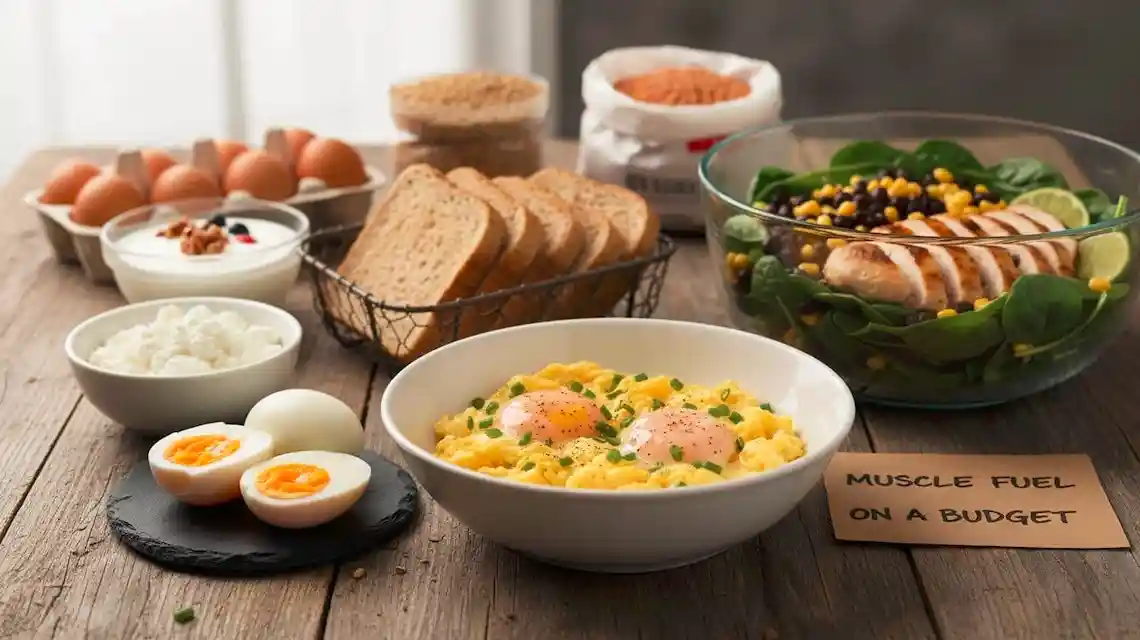

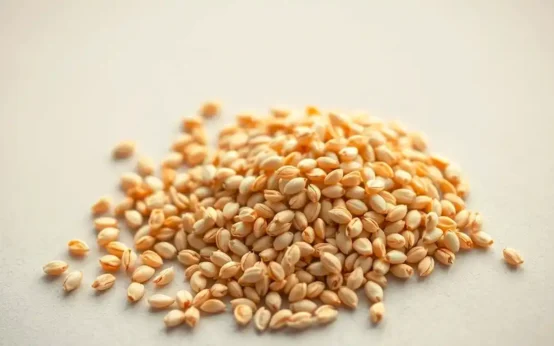 Health Benefit of Sesame Seed
Health Benefit of Sesame Seed 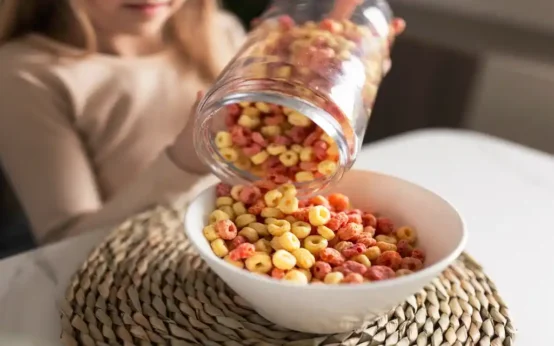 Healthiest Breakfast Cereal for Children
Healthiest Breakfast Cereal for Children 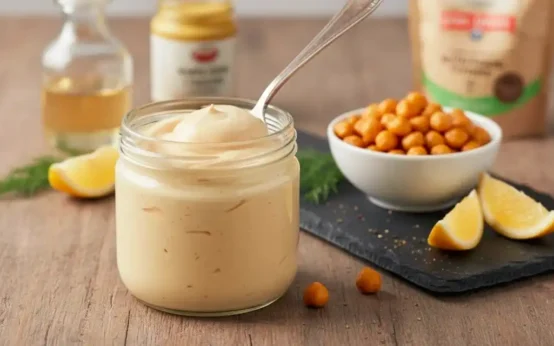 Vegan Oil Free Mayonnaise Recipe
Vegan Oil Free Mayonnaise Recipe 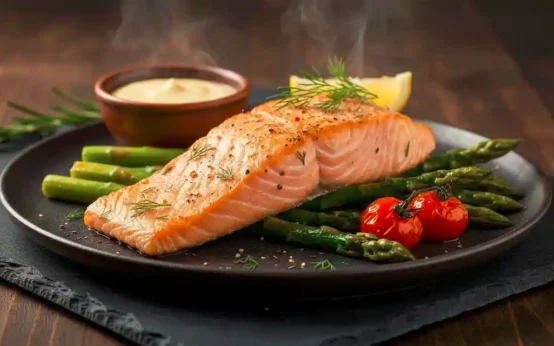 How to Cook The Salmon Fish
How to Cook The Salmon Fish  Nutrition to Enhance Athletic Performance
Nutrition to Enhance Athletic Performance 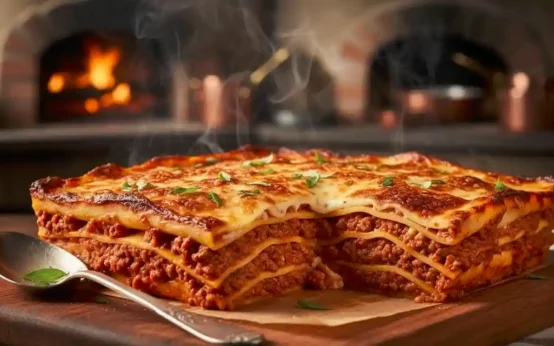 How to Cook a Lasagna at Home
How to Cook a Lasagna at Home